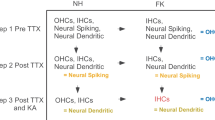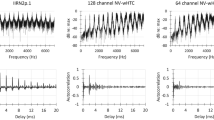Summary
Compound action potentials (CAP), summating potentials (SP) and both fundamental and second harmonic components of the cochlear microphonic (CM) were recorded from the round window and scala tympani in response to gated and continuous pure tones. The high-pass characteristics of the round-window tissues distorted the evoked d.c. response and the superimposed CAP (Fig. 2) and there was some cancellation of the resulting SP and first negative component of the CAP (Fig. 3). SP sensitivity estimates derived from the scala tympani were more sensitive than those of the round window; a.c. potentials were unaffected (Fig. 4). The SP intensity curves were found to be the most reproducible of the gross response components (Figs. 5, 6, 7). Although there was considerable variation in the group CM data, there were reproducible idiosyncrasies in the intensity curves of individuals which were attributed to unique asymmetries in the basilar papilla causing an asymmetrical stimulation of oppositely polarized hair cells. Multiple maxima in lizard CM intensity curves described by other authors are explained by different mechanisms. The general shapes of the CM and SP sensitivity curves were in agreement with those reported in previous studies (Fig. 8).
Similar content being viewed by others
Abbreviations
- CAP :
-
compound action potential
- CM :
-
cochlear microphonic
- CMF :
-
cochlear microphonic fundamental
- CMH :
-
cochlear microphonic second harmonic
- SP :
-
summating potential
References
Baird IL (1970) The anatomy of the reptile ear. In: Gans C, Parsons TS (eds) Biology of the reptilia, vol 2. Academic Press, New York London, pp 193–275
Boston JR (1980) A model of lateral line microphonic response to high level stimulation. J Acoust Soc Am 67:875–881
Cogger HG (1979) Reptiles and amphibians of Australia. AH and AW Read Pty Ltd, Sydney, pp 342–343; 584
Crawford AC, Fettiplace R (1981) Non-linearities in the response of turtle hair cells. J Physiol 315:317–338
Dallos P (1973) The auditory periphery. Academic Press, New York London, pp 32–34
Eatock RA, Manley GA, Pawson L (1981) Auditory nerve fibre activity in the tokay gecko. I. Implications for cochlear processing. J Comp Physiol 142:203–218
Furukawa T, Ishii Y (1967) Effects of static bending of sensory hair cells on sound reception in the goldfish. Jpn J Physiol 17:572–588
Gutgesell VJ (1975) Seasonal variation in the anoxia sensitivity of the lizard saccule. Comp Biochem Physiol 54A:407–408
Hepp-Reymond MC, Palin J (1968) Patterns in the cochlear potential of the tokay gecko (Gekko gecko). Acta Otolaryngol 65:270–292
Holmes RM, Fergusson B, Johnstone BM (1984) Seasonal hydration changes in the skinkTiliqua rugosa. An effect on the evoked potentials recorded from the cochlear round window. Comp Biochem Physiol (in press)
Hudspeth AJ, Corey DP (1977) Sensitivity, polarity and conductance change in the response of vertebrate hair cells to controlled mechanical stimuli. Proc Natl Acad Sci USA 74:2407–2411
Hutchinson MN (1980) The systematic relationships of the generaEgernia andTiliqua (Lacertilia: Scincidae). A review and immunological reassessment. In: Banks CB, Martin AA (eds) Proc Melbourne Herpetol Symp 1980. Zoological Board of Victoria, Melbourne, pp 176–193
Johnstone JR, Johnstone BM (1969a) Electrophysiology of the lizard cochlea. Exp Neurol 24:99–109
Johnstone JR, Johnstone BM (1969b) Unit responses from the lizard auditory nerve. Exp Neurol 24:528–537
Johnstone BM, Taylor KJ (1969) Use of probe microphones to measure sound pressure in the ear. J Acoust Soc Am 46:1404–1405
Karlan MS, Tonndorf J, Khanna SM (1972) Dual origin of the cochlear microphonics inner and outer hair cells. Ann Oto-Laryngol 81:696–704
Kauffmann G (1974) Zur Abhängigkeit der Cochleapotentiale des Kaimans vom Stoffwechsel, von aktiven Transporten und von der Temperatur. J Comp Physiol 90:245–273
Loewenstein WR, Terzuolo CA, Washizu Y (1963) Separation of transducer and impulse-generating process in sensory receptors. Science 142:1180–1181
Manley GA (1976) Auditory responses from the medulla of the monitor lizardVaranus bengalensis. Brain Res 102:329–334
Manley GA (1977) Response patterns and peripheral origin of auditory nerve fibres in the monitor lizard,Varanus bengalensis. J Comp Physiol 118:249–260
Manley GA (1981) A review of the auditory physiology of the reptiles. In: Autrum H, Ottoson O, Schmidt RF (eds) Progress in sensory physiology, vol 2. Springer, Berlin Heidelberg New York, pp 49–134
Miller MR (1966) The cochlear duct of lizards. Proc Calif Acad Sci 33:255–359
Miller MR (1974a) Scanning electron microscope studies of some skink papillae basilares. Cell Tissue Res 150:125–141
Miller MR (1974b) Scanning electron microscopy of the lizard papilla basilaris. Brain Behav Evol 10:95–112
Miller MR (1980) The reptilian cochlear duct. In: Popper AN, Fay RR (eds) Comparative studies of hearing in vertebrates. Springer, Berlin Heidelberg New York, pp 169–204
Necker R (1970) Zur Entstehung der Cochleapotentiale von Vögeln: Verhalten bei O2-Mangel, Cyanidvergiftung und Unterkühlung sowie Beobachtungen über die räumliche Verteilung. Z Vergl Physiol 69:367–425
Pierson M, Moller A (1972) Some dualistic properties of the cochlear microphonic. Hearing Res 2:135–149
Russell IJ (1981) The responses of vertebrate hair cells to mechanical stimulation. In: Roberts A, Bush BMH (eds) Society for Experimental Biology, seminar series 6: Neurones without impulses. Cambridge University Press, Cambridge, pp 119–145
Russell IJ, Sellick PM (1981) Low-frequency characteristics of intracellularly recorded receptor potentials in guinea-pig cochlea hair cells. J Physiol 338:179–206
Spoendlin H (1978) The afferent innervation of the cochlea. In: Naunton RF, Fernandez C (eds) Evoked electrical activity in the auditory system. Academic Press, New York London, pp 21–39
Turner RG (1975) The relation between whole-nerve and unit responses of the auditory nerve (alligator lizard). PhD thesis, University of Florida
Turner RG (1980) Physiology and bioacoustics in reptiles. In: Popper AN, Fay RR (eds) Comparative studies of hearing in vertebrates. Springer, Berlin Heidelberg New York, pp 205–237
Warburg MR (1965) The influence of ambient temperature and humidity on the body temperature and water loss from two Australian lizards,Tiliqua rugosa (Gray) (Scincidae) andAmphibolurus barbatus Cuvier (Agamidae). Aust J Zool 13:331–350
Weiss TF, Peake WT, Ling A, Holten T (1978) Which structures determine frequency selectivity and tonotopic organization of vertebrate cochlear nerve fibres? Evidence from the alligator lizard. In: Naunton RF, Fernandez C (eds) Evoked electrical activity in the auditory system. Academic Press, London New York, pp 21–39
Wever EG (1970) The lizard ear: Scincidae. J Morphol 132:277–292
Wever EG (1971) The mechanics of hair cell stimulation. Ann Otol Rhinol Laryngol 80:786–804
Wever EG (1978) The reptile ear. Princeton University Press, Princeton
Wever EG, Vernon JA (1957) Auditory responses in spectacled caiman. J Cell Comp Physiol 50:333–339
Wilson KJ (1974) The relationship of oxygen supply for activity to body temperature in four species of lizards. Copeia 1974:920–934
Wit HP, Blecker JD, Segenhout JH (1981) Vestibular and cochlear responses to acoustic transients. Acta Otolaryngol (Stockh) 92:409–422
Author information
Authors and Affiliations
Additional information
Cogger (1979) has suggested the inclusion of the speciesrugosa in the genusTiliqua, which has been the convention in recent publications and has the support of serological studies (Hutchinson 1980). Synonyms used in auditory studies includeTrachysaurus rugosus (Johnstone and Johnstone 1969a, b; Miller 1966),Tiliqua rugosus (Gutgesell 1975) andTrachydosaurus r. rugosus (Wever 1978). Common names include bobtail, stump-tailed, sleepy and shingleback lizard
Rights and permissions
About this article
Cite this article
Holmes, R.M., Johnstone, B.M. Gross potentials recorded from the cochlea of the skinkTiliqua rugosa . J. Comp. Physiol. 154, 719–727 (1984). https://doi.org/10.1007/BF01350225
Received:
Issue Date:
DOI: https://doi.org/10.1007/BF01350225




